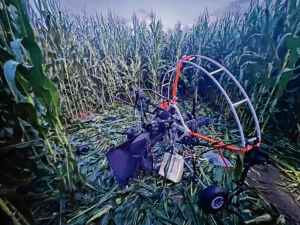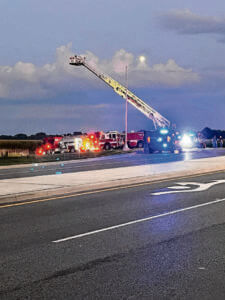These are the stories for today...
Be safe out there!
Tom
Paraglider crashes near Indianapolis Regional Airport; pilot taken to hospital
By Kristy Deer
COMFORT — A person was injured in a paraglider accident near Indianapolis Regional Airport Monday night.
paraglider accident near Indianapolis Regional Airport Monday night.
Local police and fire personnel responded to the airport, following a call that came in about 8:40 p.m. The paraglider went into a cornfield, which was clearly seven to eight feet high, making it difficult for crews to see exactly where the paraglider and pilot were located following the crash.
Buck Creek Township Fire Chief Brandon Wilch said they are confirming but he’d been told people in the community room at the department’s Station 71, which sits on Airport Boulevard, were looking out the window watching the craft when there appeared to be problems with it causing it to go down, so they immediately notified firefighters.
Wilch noted first responders sprang into action and used drones to help them find the pilot of the paraglider after it went into a massive cornfield along County Road 600 West.
action and used drones to help them find the pilot of the paraglider after it went into a massive cornfield along County Road 600 West.
“Our staff was alerted, and our staff started a response, and we started looking with the aid of some drones and other personnel to find out where the crash happened,” Wilch said. “Once we located the accident scene we had to find the easiest access to get back to the patient and then get the person out of the cornfield.”
Wilch noted there was only one crash victim and he did not know the person’s status, only that the person was transported to an Indianapolis hospital.
“It is one of those things that is an infrequent type of thing that we don’t normally have to worry about,” Wilch said about the paraglider crash. “But, the good thing is we have lots of resources and our crews train for all kinds of emergencies.”
Emergency vehicles could be seen everywhere at the roundabout located at 600 West and Airport Boulevard, where crews from Buck Creek Township were assisted by personnel from Vernon Township Fire Department, Sugar Creek Township Fire Department, Hancock County Sheriff’s Department and Cumberland Police Department.
The Daily Reporter will add more details about the crash when they become available.
https://www.greenfieldreporter.com/2025/07/14/paraglider-crashes-near-indianapolis-regional-airport-pilot-taken-to-hospital/
NTSB Final Report: Kjelsrud Gary Kitfox
Airplane Exhibited A Partial Loss Of Engine Power When It Was About Halfway Down The Runway
Location: Powell, Wyoming Accident Number: WPR24LA148
Date & Time: May 10, 2024, 10:30 Local Registration: N605GK
Aircraft: Kjelsrud Gary Kitfox Aircraft Damage: Substantial
Defining Event: Loss of engine power (partial) Injuries: 1 None
Flight Conducted Under: Part 91: General aviation - Personal
Analysis: The pilot of the experimental amateur-built airplane was departing from his private dirt strip when the accident occurred. The airplane exhibited a partial loss of engine power when it was about halfway down the runway. The pilot elected to proceed with the takeoff due to an irrigation canal at the end of the runway. The airplane would not gain altitude and subsequently struck two fences before nosing over and coming to rest inverted in a nearby yard.
Postaccident examination of the engine revealed that one of the two piston-type carburetors had the retaining clip for the jet needle set to the leanest position. The other carburetor was set to the engine manufacturer’s specified position. It is likely that the overly lean setting in one of the carburetors caused the carburetors not to be synchronized, which resulted in the partial loss of engine power during takeoff. According to the pilot, he adjusted the carburetor’s retaining clip to lower the cylinder temperature while he was flying in a different state and did not notice any loss of engine performance. However, this was his first attempted takeoff in Wyoming, that was located at a high elevation.
Probable Cause and Findings: The National Transportation Safety Board determines the probable cause(s) of this accident to be -- The pilot’s adjustment of the carburetor to an incorrect setting, which resulted in partial loss of engine power during takeoff.
FMI: www.ntsb.gov

Today in History
16 Years ago today: On 15 July 2009 Caspian Airlines flight CPN7908, a Tupolev Tu-154M, crashed following a loss of control near Qazvin, Iran, killing all 168 occupants.
| Date: | Wednesday 15 July 2009 |
| Time: | 11:53 |
| Type: | Tupolev Tu-154M |
| Owner/operator: | Caspian Airlines |
| Registration: | EP-CPG |
| MSN: | 87A748 |
| Year of manufacture: | 1987 |
| Total airframe hrs: | 26593 hours |
| Cycles: | 16248 flights |
| Engine model: | Soloviev D-30KU-154-II |
| Fatalities: | Fatalities: 168 / Occupants: 168 |
| Other fatalities: | 0 |
| Aircraft damage: | Destroyed, written off |
| Category: | Accident |
| Location: | 12 km S of Qazvin - Iran |
| Phase: | En route |
| Nature: | Passenger - Scheduled |
| Departure airport: | Tehran-Imam Khomeini International Airport (IKA/OIIE) |
| Destination airport: | Yerevan Airport (EVN/UDYZ) |
| Investigating agency: | AAID Iran |
| Confidence Rating: | Accident investigation report completed and information captured |
Narrative:
Caspian Airlines flight CPN7908, a Tupolev Tu-154M, crashed following a loss of control near Qazvin, Iran, killing all 168 occupants.
The airplane departed Tehran-Imam Khomeini International Airport (IKA), Iran to Yerevan Airport (EVN), Armenia.
After takeoff the flight was cleared to climb to 32000 feet. While climbing through at 28800 feet, the plane suddenly turned 270 degrees and entered a rapid descent to 14700 feet in just 55 seconds (which would be an average of 256 feet/sec). Air traffic controllers attempted to contact the flight, but there was no response. They asked two Iran Air an Aseman Airlines flights that were in the area to contact Flight 7908, but these attempts failed too.
The airplane exploded on impact and disintegrated, creating a 10 m deep crater with small pieces of debris scattered around the impact area.
A fatigue failure of a disk of the first stage of the low-pressure compressor (LPC) of engine no.1. The uncontained failure of this part in the tail of the aircraft resulted in a loss of control.
